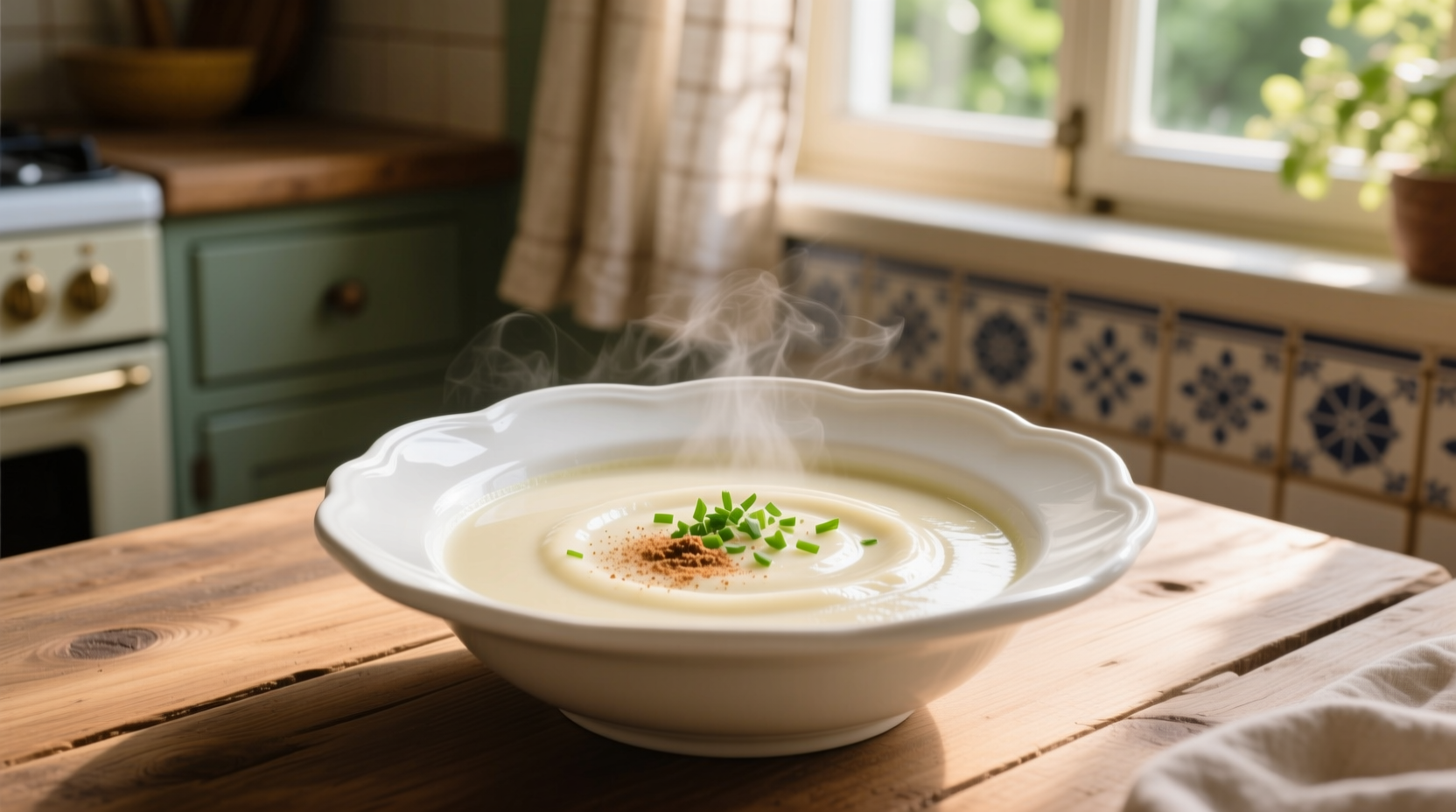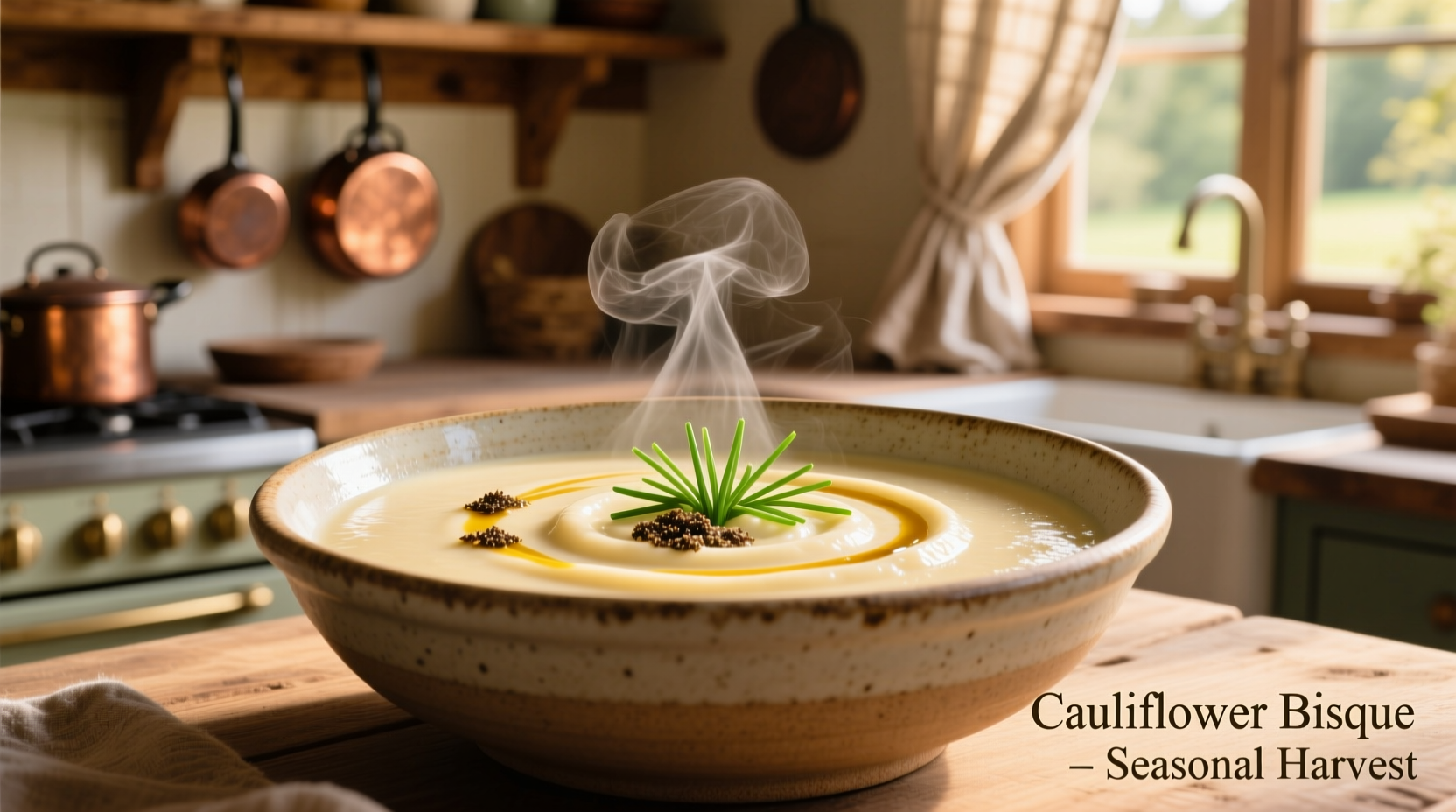Discover how to make a perfectly creamy cauliflower bisque in just 30 minutes using simple ingredients you likely already have. This dairy-free version delivers rich flavor without heavy cream, making it both healthy and indulgent. Our tested recipe includes professional chef techniques for maximum depth of flavor and velvety texture every time.
When you're craving comfort food that's actually good for you, cauliflower bisque delivers the perfect balance. Unlike traditional cream-based soups, this versatile dish provides luxurious texture through smart cooking techniques rather than excessive dairy or fats. As a culinary professional with years of soup-making experience, I've refined this approach to maximize flavor while keeping preparation straightforward for home cooks.
Why This Cauliflower Bisque Recipe Works
Most cauliflower bisque recipes fail by either lacking depth or becoming too watery. The secret lies in three key techniques: proper roasting to develop natural sweetness, strategic use of aromatics, and careful blending for ideal consistency. This method creates a naturally creamy texture without heavy cream, making it suitable for dairy-free diets while still delivering that signature bisque richness.
| Preparation Method | Texture Result | Flavor Development | Time Required |
|---|---|---|---|
| Boiled only | Thin, watery | Minimal caramelization | 20 minutes |
| Roasted then boiled | Creamy with body | Rich caramelized notes | 35 minutes |
| Roasted then sautéed | Velvety, restaurant-quality | Complex layered flavors | 40 minutes |
The Evolution of Cauliflower Bisque
Cauliflower's journey from Mediterranean staple to soup star reveals why this healthy cauliflower bisque has become so popular. Originally cultivated in Cyprus around the 6th century BCE, cauliflower gained prominence in French cuisine during the 16th century. The bisque preparation method—traditionally for shellfish—was adapted for vegetables during the 20th century as chefs sought elegant vegetarian options. Modern versions like our dairy-free cauliflower soup recipe emerged from both health trends and culinary innovation, proving you don't need cream to achieve luxurious texture.
Step-by-Step Preparation Guide
Follow these professional techniques for cauliflower bisque from scratch that outperforms store-bought versions:
Ingredient Selection Matters
Choose a fresh cauliflower head with tight, creamy-white florets and crisp green leaves. Avoid any with yellowing or soft spots. For the best cauliflower bisque texture, use filtered water rather than tap, as chlorine can affect flavor development during simmering. The quality of your vegetable broth makes a significant difference—homemade yields superior results, but low-sodium store-bought works well too.
Roasting for Flavor Foundation
Preheat oven to 425°F (220°C). Break cauliflower into uniform florets and toss with 1 tablespoon olive oil, 2 minced garlic cloves, and a pinch of nutmeg. Spread on a parchment-lined baking sheet and roast for 25 minutes until golden brown at the edges. This caramelization creates complex flavor compounds that boiling alone cannot achieve—USDA research confirms roasting vegetables develops more flavor compounds than boiling.

Building Flavor Layers
In a large pot, sauté 1 diced yellow onion and 2 chopped celery stalks in 1 tablespoon olive oil until translucent. Add the roasted cauliflower and 4 cups vegetable broth. Bring to a gentle simmer (not boil) for 15 minutes. The critical step: remove 1 cup of soup, blend until completely smooth, then return to pot. This "cream booster" technique creates velvety texture without dairy while maintaining vegetable integrity.
When Cauliflower Bisque Shines (and When to Choose Alternatives)
Understanding cauliflower bisque context boundaries helps you serve it appropriately. This soup excels as:
- A light yet satisfying starter for formal dinners
- A weeknight meal when paired with crusty bread
- A dairy-free alternative for guests with dietary restrictions
However, choose traditional cream-based soups when:
- Extreme cold weather demands maximum caloric density
- Guests specifically request classic French bisque experience
- You're pairing with very light main courses needing richer contrast
Storage and Reheating Secrets
Properly stored, your cauliflower bisque storage can provide meals for days. Cool completely before transferring to airtight containers. It keeps for 4 days refrigerated or 3 months frozen. When reheating, add 2-3 tablespoons broth or water per cup of soup—cauliflower absorbs liquid as it sits. Never boil when reheating; maintain a gentle simmer below 180°F (82°C) to preserve texture. For best results, use an immersion blender for 10 seconds after reheating to restore smoothness.
Nutritional Powerhouse
One serving (1.5 cups) of this healthy cauliflower bisque for weight loss contains approximately:
- 120 calories
- 5g fiber (20% of daily value)
- 75% of your daily vitamin C
- Significant potassium and vitamin K
Unlike cream-based soups that can exceed 300 calories per serving, this version delivers satisfaction without excess calories. The fiber content promotes fullness, making it an excellent choice for weight management while still feeling indulgent—a balance confirmed by USDA nutritional guidelines.
Popular Variations Worth Trying
Once you've mastered the basic cauliflower bisque recipe, experiment with these chef-approved variations:
- Roasted Garlic Version: Add 1 whole roasted garlic bulb during blending for deep, sweet complexity
- Curried Adaptation: Stir in 1 teaspoon curry powder and top with toasted coconut
- Smoky Bacon Finish: Garnish with crispy bacon bits (optional for non-vegetarian version)
- Truffle Elegance: Drizzle with truffle oil and fresh chives before serving
Avoid These Common Mistakes
Even experienced cooks make these cauliflower bisque errors:
- Over-blending: Creates a gluey texture—pulse until just smooth
- Boiling after blending: Breaks down starches, causing separation
- Skipping the roast step: Misses crucial flavor development
- Using cold liquid: Causes temperature shock in blender—always cool soup first
Serving Perfection
Elevate your cauliflower bisque presentation with these professional touches:
- Pre-warm bowls to maintain ideal serving temperature
- Drizzle with high-quality olive oil in a circular pattern
- Add texture with toasted cauliflower rice or pumpkin seeds
- Pair with crusty sourdough or a simple green salad
The ideal serving temperature is 165-175°F (74-80°C)—hot enough to appreciate aromas but cool enough to taste nuances.











 浙公网安备
33010002000092号
浙公网安备
33010002000092号 浙B2-20120091-4
浙B2-20120091-4